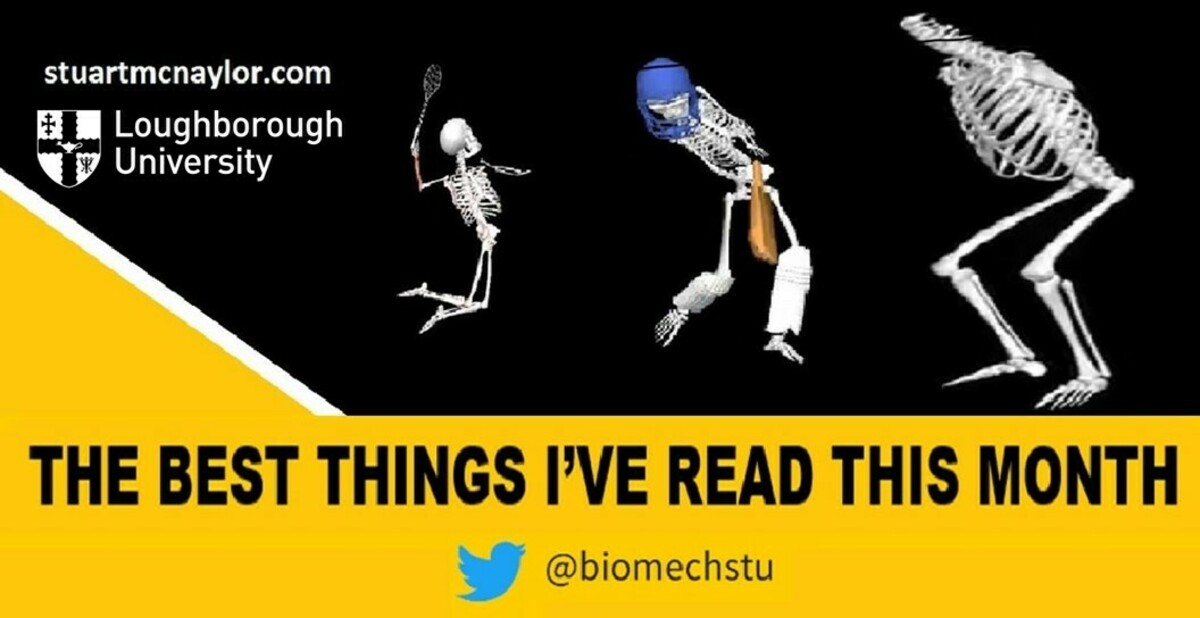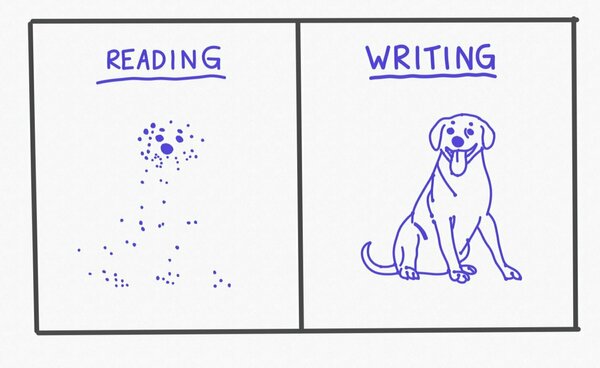
Welcome to the 73 new people who have subscribed since last month! Thank you to Helen and ‘Cricket Pinches’ for sharing it online, and to everyone who shared my post on Twitter or LinkedIn. If you do find it useful, please share this link with any colleagues, students, or others who might like it.
Here’s what I would like to share with you this month… As usual, there are two sections: ‘What Have I Been Up To?’ and ‘What Have I Been Reading?’
What Have I Been Up To?
Read to collect the dots. Write to connect them. I love this quote, and image, by David Perell. As I branch into a new/adjacent area of research, the last month has mostly consisted of me collecting the dots. I have a lot of writing to do this month, though, and am looking forward to connecting those dots and hopefully forming some new research ideas.
Weightlifting derivatives study: We published a paper in Journal of Sports Sciences investigating the effects of barbell mass on force and velocity time series data during the countermovement shrug. I really enjoyed working on this one with the team at the University of Salford. The paper is Open Access, or you can see a brief overview in the Twitter thread below:
Comparing biomechanical time series data across countermovement shrug loads
— Stuart McErlain-Naylor (@biomechstu) August 18, 2022
New #OpenAccess 🔓 paper in @JSportsSci with @meechan1983, @ForcePlateCoach, @DrTSuchomel, & @PaulComfort1975
Brief summary in thread below 🧵 pic.twitter.com/pJpkw1LjO1
What Have I Been Reading?
Now for the main part of the newsletter…
Training load as exposure and dose: This new preprint positions training load in relation to terms and frameworks commonly used in more clinically focused disciplines. Aspects addressed include the terminology used, but more importantly the need to position measures or metrics within a causal pathway leading to the response of interest. Implications for context-dependent validity are also discussed.
Tibial bone forces from wearables: We know from previous research that tibial bone forces during running are mostly dependent on muscle forces rather than ground reaction forces. This can make it difficult to monitor the particular aspect of loading with externally mounted sensors. However, this recent paper demonstrates the ability to estimate tibial bone forces from shoe-worn IMU and insole data alongside a machine learning approach. For a great overview of the implications and back-story of the study, check out this thread.
Biomechanical load in nursing: In this study , lumbar loads were simulated for 86 nursing tasks in a hospital unit and used as inputs in a discrete event model of the care-delivery process. This created a shift-long trace of the biomechanical load. A novel example of pulling in data from various sources to estimate load in a practical scenario, and a few ideas for sports biomechanists to contemplate.
Adding noise to musculoskeletal simulations: This paper presents a method to simulate neuro-musculoskeletal models in the presence of noise, investigating the effects of noise on movement strategies. This enables a true minimum effort movement solution to be identified by directly observing/quantifying movement accuracy rather than approximating it.
Are power analyses reproducible? According to this preprint , only 13% of motor behaviour articles included a power analysis. Of those, only 7% provided sufficient detail for the calculation to be successfully reproduced. Even with typical/plausible missing values assumed, this only rose to 43%. The article (and this thread ) goes into detail about the common mistakes, omissions, and trends. It’s a useful read to improve the quality of our own reporting.
Guidelines for motor learning studies: A recent article providing a series of ten guidelines for designing lab-based motor learning experiments. This covers aspects from task selection and instructions given to measures of learning and data processing.
Running shoe technology: A ‘current concepts’ overview paper explaining recent advancements in running shoe technology and their effects on running economy and performance. It covers the controversial topic of super shoes and super spikes. Features discussed include longitudinal bending stiffness, the ‘teeter-totter effect’, energy return properties of the midsole, stack height, and shoe mass. It’s worth noting that this paper is currently free for all to access but only until the end of the month.
Global survey of biomechanics teachers: A survey of 181 biomechanics instructors reveals global trends in teaching styles, experiences, and perceptions. Results are compared between continents, and particular emphasis is given to the transition to online learning due to COVID-19.
An AI dictionary for sport scientists: For those reading machine learning papers and struggling with the terminology, this blog post will be particularly useful. The ‘dictionary’ explains general terminology and types of machine learning algorithms, datasets, analyses, and metrics, among other terms.
The month of Zelik: In addition to the tibial bone force paper mentioned above, Karl Zelik has been taking part in the online Ship 30 for 30 digital writing course. This has involved writing and sharing a mini-essay or thread every day for 30 days. You can see all of these posts here or on Karl’s Twitter profile , but my personal highlights have included tips to jumpstart your career as an early career researcher, tips for scientific presentations, tips for grant writing, and lessons for translating your research beyond the laboratory. This series is still ongoing, so keep an eye out for more shared wisdom and experience.
Guide to running a group: If you want useful tips or frameworks for running a business or research group, supervising, or anything similar then this collection is excellent. The in-depth rabbit-hole of advice and experiences includes topics such as organising and running meetings, giving and receiving feedback, building relationships, time management, and much more.
Injuries in cricket: How does lumbar bone mineral density (BMD) differ between cricket fast bowlers with and without lumbar stress fracture, and do BMD trajectories differ between groups during rehabilitation? This study answered these questions, with implications for injury prevention and rehabilitation. On the topic of cricketing injuries, a systematic review and meta-analysis described the incidence and prevalence of injuries among female cricket players of all ages, participating in all levels of play. A nice visual summary can be seen in this thread.
Thank You
That’s all for this month. If you found it useful, please forward this email or share this link with colleagues, students, or on social media.
Take care, and thank you for reading. I hope you have a great September!
Stu
